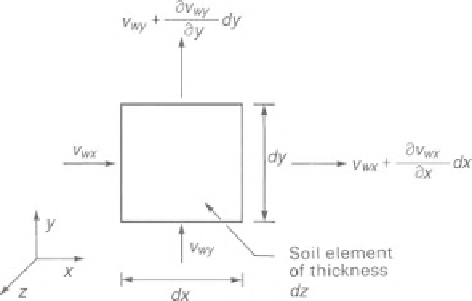Environmental Engineering Reference
In-Depth Information
the coefficient-of-permeability
k
wy
u
a
−
u
w
term will be
written as
k
wy
for simplicity. Rewriting Eq. 7.29 and con-
sidering the nonzero dimensions for
dx
,
dy
, and
dz
gives
the following nonlinear differential equation:
7.4.6 Two-Dimensional Flow through Unsaturated Soil
Seepage through an earth dam constitutes a common
example of two-dimensional flow. Let us assume that water
flows through the cross-sectional plane of the dam while
flow in the perpendicular plane is negligible. Historically, it
was conventional practice to neglect the flow of water in the
unsaturated zone of the dam. The seepage analysis presented
herein assumes that water flows through both the saturated
and unsaturated zones in response to a hydraulic head driving
potential.
The following two-dimensional formulation is an
expanded form of the previous one-dimensional flow
equation. The formulation is called an uncoupled solution
since only the continuity of the water phase is satisfied.
For a more rigorous formulation of two-dimensional water
flow, continuity would need to be coupled with the force
equilibrium equations (see Chapter 16).
The following derivation is for the general case of a
het-
erogeneous
,
anisotropic
, unsaturated soil (Fig. 7.21b). The
coefficients of permeability in the
x
-direction,
k
wx
, and the
y
-
direction,
k
wy
, are assumed to be related to matric suction by
d
2
h
w
dy
2
dk
wy
dy
dh
w
dy
=
k
wy
+
0
(7.30)
where:
dk
wy
/dy
=
change in water coefficient of permeability
in the
y
-direction due to changes in matric
suction.
The nonlinearity in the differential equation for flow is
caused by its second term, which accounts for the variation
in permeability with respect to space. When the soil becomes
saturated
, the water coefficient of permeability
k
wy
can be
taken as being equal to a single-valued, saturated coefficient
of permeability
k
s
. If the saturated soil is heterogeneous
(e.g., layered soil), the coefficient of permeability will again
vary with respect to location. In a saturated soil, the hetero-
geneous distribution of the
soil solids
is the primary factor
producing a varying coefficient of permeability. As a result,
the flow equation can be written as follows:
the same form for the permeability function,
k
w
u
a
−
u
w
.
The ratio of the coefficients of permeability in the
x
- and
y
-
directions
k
wx
/k
wy
is assumed to be constant at any point
within the soil mass.
A soil element with infinitesimal dimensions of
dx
,
dy
, and
dz
is considered, but flow is assumed to be two
dimensional (Fig. 7.24). The flow rate
v
wx
is positive when
water flows in the positive
x
-direction. The flow rate
v
wy
is positive for flow in the positive
y
-direction. Continuity
for two-dimensional, steady-state flow can be expressed
as follows:
v
wx
+
d
2
h
w
dy
2
dk
s
dy
dh
w
dy
=
k
s
+
0
(7.31)
where:
k
s
=
saturated coefficient of permeability.
v
wx
dy dz
∂
v
wx
∂x
Comparing Eqs. 7.30 and 7.31 reveals a similar form.
In other words, the nonlinearity in the unsaturated soil flow
equation produces the same form of equation as that required
for a heterogeneous, saturated soil. In an
unsaturated
soil,
the variation in the coefficient of permeability is caused
by the heterogeneous distribution of the pore-fluid volume
occurring as a result of different matric suction values.
If a saturated soil is
homogeneous
, the coefficient of per-
meability is constant for the entire soil mass. Substituting a
nonzero, constant coefficient of permeability into Eq. 7.31
produces a linear differential equation:
dx
−
v
wy
+
v
wy
dx dz
∂
v
wy
∂y
+
dy
−
=
0
(7.33)
d
2
h
w
dy
2
=
0
(7.32)
Equations similar to Eq. 7.31 can also be derived for one-
dimensional flow in the
x
- and
z
-directions, but in these
cases there is no elevation component contributing to the
gradient. In other words, it can be stated that flow in the
x-
and
z-
(horizontal) directions occurs as a result of pressure
head gradients while flow in the
y-
direction occurs due to
hydraulic head gradients.
Figure 7.24
Two-dimensional water flow through an unsaturated
soil element.










Search WWH ::

Custom Search